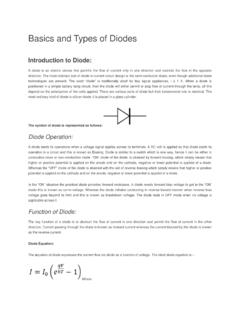Transcription of 8843-12 Beam shaping to generate uniform laser …
1 Beam shaping to generate uniform laser light sheet and Linear laser Spots Alexander Laskin, Vadim Laskin AdlOptica GmbH, Rudower Chaussee 29, 12489 Berlin, Germany ABSTRACT Generation of laser light sheet beams and linear laser spots characterized by uniform irradiance distribution is important in various laser techniques like Particle Image Velocimetry (PIV), laser -Induced Fluorescence (LIF), hardening, annealing, cladding, uniform laser illumination of linear spatial light modulators. This task can be successfully solved with using refractive beam shaping optics of field mapping type in combination with additional optical components.
2 Due to their unique features: low output divergence, high transmittance, flatness of output phase front and irradiance profile, as well as extended depth of field, the refractive field mappers provide freedom in further manipulation of intensity profile and shape of output beam. Typically design of refractive field mapping beam shapers has circular symmetry; therefore to create linear spot shapes it is suggested to apply anamorphic optical components like cylinder lenses, prism pairs, etc. The combined beam shaping systems allow achieving very high aspect ratio, up to 1:1000, of linear spots with simultaneous providing extended depth of field, it is possible to realize a laser light sheet characterized by keeping uniform intensity of linear spot over extended distance along optical axis.
3 This paper will describe some design basics of refractive beam shapers of the field mapping type and optical layouts for creating linear laser spots and laser light sheet . Examples of real implementations will be presented as well. Keywords: beam shaping , flattop, tophat, laser line, laser light sheet , hardening, cladding, PIV, LIF. 1. INTRODUCTION The tasks of creating a linear laser spot with uniform intensity along its length are today frequently asked in many industrial and scientific applications, some of them are mentioned above. And using various beam shaping optics2 is typical approach to solve these tasks with providing high efficient usage of laser energy and high homogeneity.
4 The solutions on the base of field mapping refractive beam shapers like Shaper are featured by high flexibility in building of different beam shaping optical layouts due to their unique features: high transmittance, capability to work with TEM00 and multimode lasers, conserving consistency of laser beam and, hence, low output divergence, flatness of output wave front and intensity profiles. Therefore, it is possible to apply ordinary optical components, very often just off-the-shelf optics, in combination with a beam shaper and realize an optimum for a particular application shape and profile of laser spot.
5 Low beam divergence provided by refractive beam shapers makes it possible to realize so called laser light sheet the beam specified by uniform intensity in one section, small width in another section and extended depth of field. There will be considered in this paper some practical optical layouts built on the base of Shapers with emphasize on features being important for particular laser techniques. 2. THEORETICAL CONSIDERATIONS For purposes of clarity of further considerations it is important to describe some basic features of refractive beam shapers and behavior of flattop laser beams while propagation in space and focusing.
6 Refractive Beam Shaper Among popular types of beam shaping optics the field mapping refractive beam shapers1,2,3,4 like Shaper6,7,10,11,12, Fig. 1, demonstrate high flexibility in building various optical systems due to their principle of operation implying saving of beam consistency and providing a flat wave front of output beam. Their main optical features are: - refractive optical systems to transform laser intensity distribution from Gaussian to flattop (tophat, uniform ); - almost 100% efficiency; - high transmittance; - the transformation is realized through the phase profile manipulation in a control manner, without deterioration of the beam consistency and increasing its divergence; - changing the input beam diameter leads to changing the output profile: o round Gaussian input is transformed to round flattop output beam, o elliptic Gaussian input is transformed to Roof-like output beam.
7 - the output phase profile is maintained flat, hence output beam has low divergence; - adaptability to real lasers through variation of distance between the Shaper components; - TEM00 or multimode beams applied; - Output beam is collimated and resulting beam profile is kept stable over large distance; - Galilean design, no internal focusing; Figure 1 Principle of the Shaper operation - achromatic optical design - several lasers can be used simultaneously. presents experimental data with TEM00 laser . Figure 2 Experimental and theoretical intensity profiles: Left Input TEM00 beam, Right - after the Shaper (Courtesy of laser -Laboratorium G ttingen ) Important feature of the refractive field mapping beam shapers is that the transformation is realized in control manner by accurate introducing and further compensation of wave aberration, therefore the resulting collimated output beam has low divergence and there is no deterioration of the beam consistency.
8 On the other hand this allows adapting the beam shapers to create final laser spots of required shape and intensity profile. Most popular implementation of the refractive beam shapers is telescopic optical system transforming collimated Gaussian or Gaussian-like beam to collimated beam with uniform intensity. The design technique allows also creating collimating Shaper realizing transformation of divergent Gaussian input beam to collimated flattop output; this type of beam shapers is important for more and more popular fiber lasers as well as fiber-coupled diode and solid-state lasers. There is one more important feature of the refractive field mapping beam shapers their operational principle presumes the input beam has a certain size - usually defined as diameter at 1/e2 intensity level, and a certain intensity profile - Gaussian or similar profiles with peak intensity in the centre.
9 If an input beam size differs from the pre-determined one the resulting profile deviates from the flattop as well, for example, when an input beam is essentially smaller, say 2-3 times less than a specified value, the beam shaper operates as an ordinary beam-expander, so the output beam is about times expanded but the resulting profile stays almost the same like at the entrance Gaussian. This effect is demonstrated on Fig. 1. It can be used, for example, to generate a Roof-like beam profile with uniform intensity in one direction and Gaussian in another one this is easily achieved when an elliptic input beam with a long axis of proper length (according to a Shaper design), Fig.
10 1. With using the effect of dependence of output beam profile and shape from the input beam size it is possible to build various optical system realizing various shapes and intensity profiles of final laser spots. In contrast to many other beam shaping techniques the physical principle of operation of refractive field mappers doesn t require the input beam to be obligatory a TEM00 one, to have a common phase front. The beam shapers like Shaper work perfect with multimode beams as well, the only condition is that the irradiance distribution of input beam to be similar to Gaussian function, to have irradiance characterized by peak in center and decreasing towards periphery, for example parabolic.




